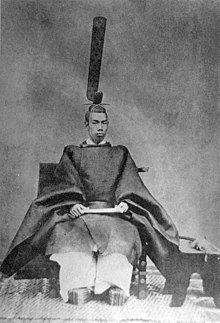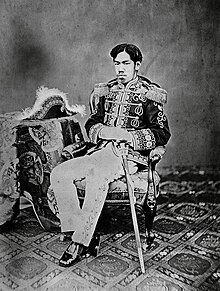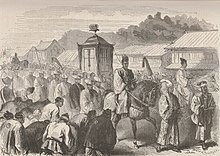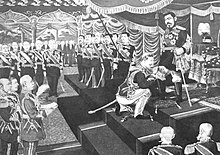Emperor Meiji
| Emperor Meiji 明治天皇 | |||||
|---|---|---|---|---|---|
 | |||||
| 122nd Emperor of Japan | |||||
| Reign | 3 February 1867 – 30 July 1912 (45 years, 178 days) | ||||
| Predecessor | Emperor Kōmei | ||||
| Successor | Emperor Taishō | ||||
| Prime Ministers | |||||
| Burial | 13 September 1912 Fushimi Momoyama no Misasagi (伏見桃山陵), Kyoto | ||||
| Spouse | Ichijō Masako | ||||
| Issue | Prince Tōgu, later Emperor Taishō Princess Masako Princess Fusako Princess Nobuko Princess Toshiko | ||||
| |||||
| House | House of Yamato | ||||
| Father | Emperor Kōmei | ||||
| Mother | Nakayama Yoshiko | ||||
The Meiji Emperor (明治天皇, Meiji-tennō) (3 November 1852 - 30 July 1912) or Meiji the Great was the 122nd emperor of Japan according to the traditional order of succession, reigning from 3 February 1867 until his death.
Like all his predecessors, since his death he has been referred to by a posthumous name. Upon his death a new tradition of giving the late emperor the name of the era coinciding with his reign was established. Having ruled during the Meiji era (Enlightened rule), he is now known as Emperor Meiji.
His personal name was Mutsuhito (睦仁), and although outside of Japan he is sometimes called by this name or Emperor Mutsuhito, in Japan emperors are referred to only by their posthumous names. Use of an emperor's personal name would be considered too familiar, or even blasphemous.
At the time of his birth in 1852, Japan was an isolated, pre-industrial, feudal country dominated by the Tokugawa Shogunate and the daimyo, who ruled over the country's more than 250 decentralized domains. By the time of his death in 1912, Japan had undergone a political, social, and industrial revolution at home (See Meiji Restoration) and emerged as one of the great powers on the world stage.
A detailed account of the State Funeral in the New York Times concluded with an observation: "The contrast between that which preceded the funeral car and that which followed it was striking indeed. Before it went old Japan; after it came new Japan."[1]
Events of the Meiji emperor's life


The Meiji emperor was the surviving son of Emperor Kōmei by the lady-in-waiting Nakayama Yoshiko (中山慶子, 1834–1907),[2] the daughter of Lord Nakayama Tadayasu, sometime minister of the left (sadaijin) and a scion of the Fujiwara. He was born eight months before the arrival of Commodore Matthew Calbraith Perry and the United States squadron of "Black Ships" in Edo Bay and two years before the first of the unequal treaties which the Tokugawa shogunate signed with Perry. Originally titled Sachi-no-miya (Prince Sachi), the future emperor spent most of his childhood at the Nakayama household in Kyoto, as it was customary to entrust the upbringing of imperial children to prominent court members.
He was formally adopted by Asako Nyōgō (later Empress Dowager Eishō), the principal consort of Emperor Kōmei, on 11 July 1860. He also received the personal name Mutsuhito, the rank of Shinnō (Imperial Prince, and thus a potential successor to the throne) and the title of Kōtaishi (Crown Prince) on the same day. Crown Prince Mutsuhito acceded to the throne on 3 February 1867 at the age of fourteen. In the ninth month of the following year, the era was changed to Meiji, or “enlightened rule”, which was later used for the emperor's posthumous name. This marked the beginning of the custom of an era coinciding with an emperor's reign, and posthumously naming the emperor after the era during which he ruled.
On 11 January 1869, the Meiji emperor married Masako (later renamed Haruko) (9 May 1849–19 April 1914), the third daughter of Lord Ichijō Tadaka, sometime minister of the left (sadaijin). Known posthumously as Empress Shōken, she was the first Imperial Consort to receive the title of kōgō (literally, the Emperor's wife, translated as Empress Consort), in several hundred years. Although she was the first Japanese Empress Consort to play a public role, she bore no children. However, the Meiji emperor had fifteen children by five official ladies-in-waiting. Only five of his children, a prince born to Lady Naruko (1855–1943), the daughter of Yanagiwara Mitsunaru, and four princesses born to Lady Sachiko (1867–1947), the eldest daughter of Count Sono Motosachi, lived to adulthood. They were:
- Crown Prince Yoshihito (Haru no miya Yoshihito Shinnō), 3rd son, (31 August 1879–25 December 1926) (see Emperor Taishō).
- Princess Masako (Tsune-no-miya Masako Naishinnō), 6th daughter, (30 September 1888–8 March 1940), titled Tsune-no-miya (Princess Tsune) until marriage; m. at Imperial Palace, Tokyo, 30 April 1908 to Prince Takeda Tsunehisa (Takeda-no-miya Tsunehisa ō, 22 September 1882–23 April 1919), and had issue (offspring).
- Princess Fusako (Kane-no-miya Fusako Naishinnō), 7th daughter, (28 January 1890–11 August 1974), titled Kane-no-miya (Princess Kane) until marriage; m. at Imperial Palace, Tokyo 29 April 1909 to Prince Kitashirakawa Naruhisa (Kitashirakawa-no-miya Naruhisa ō, 1 April 1887–2 April 1923), and had issue.
- Princess Nobuko (Fumi-no-miya Nobuko Naishinnō), 8th daughter, (7 August 1891–3 November 1933); titled Fumi-no-miya (Princess Fumi) until marriage; m. at Imperial Palace, Tokyo 6 May 1909 to Prince Asaka Yasuhiko (Asaka-no-miya Yasuhiko ō, 2 October 1887–13 April 1981), and had issue.
- Princess Toshiko (Yasu-no-miya Toshiko Naishinnō), 9th daughter, (11 May 1896–5 March 1978); titled Yasu-no-miya (Princess Yasu) until marriage; m. at Imperial Palace, Tokyo 18 May 1915 to Prince Higashikuni Naruhiko (Higashikuni-no-miya Naruhiko ô, 3 December 1887–20 January 1990), and had issue.
Meiji Restoration


The Meiji emperor was the symbolic leader of the Meiji Restoration, in which the Tokugawa shogunate was abolished by Imperial forces following the Boshin War. The Charter Oath, a five-point statement of the nature of the new government, abolished feudalism and proclaimed a modern democratic government for Japan. Although a parliament was formed, it had no real power, and neither did the emperor. Power had passed from the Tokugawa into the hands of those Daimyo and other samurai who had led the Restoration. Japan was thus controlled by the Genro, an oligarchy, which comprised the most powerful men of the military, political, and economic spheres. The emperor, if nothing else, showed greater political longevity than his recent predecessors, as he was the first Japanese monarch to remain on the throne past the age of 50 since the abdication of Emperor Ōgimachi in 1586.
The Meiji Restoration is a source of pride for the Japanese, as it and the accompanying industrialization allowed Japan to become the preeminent power in the Pacific and a major player in the world within a generation. Yet, the Meiji emperor's role in the Restoration is debatable. He certainly did not control Japan, but how much influence he wielded is unknown. It is unlikely it will ever be clear whether he supported the Sino-Japanese War (1894–1895) or the Russo-Japanese War (1904–1905). One of the few windows we have into the Emperor's own feelings is his poetry, which seems to indicate a pacifist streak, or at least a man who wished war could be avoided. He composed the following pacifist poem or tanka:
- よもの海
- みなはらからと思ふ世に
- など波風のたちさわぐらむ
- Yomo no umi
- mina harakara to omofu yo ni
- nado namikaze no tachi sawaguramu
- (literal translation)
- Whilst the oceans in all directions,
- I believe, are all my friends,
- I only wonder why they should be any rough.
- (free translation)
- Believing that the peoples in the world
- being all my friends,
- we should not conflict each other.
Near the end of his life several anarchists, including Kotoku Shusui, were executed on charges of having conspired to murder the sovereign. This conspiracy was known as the High Treason Incident.
Timeline of Events during the Life and Reign of the Meiji Emperor
The Meiji era ushered in many far-reaching changes to the ancient feudal society of Japan. Presented here is a timeline of those major events:
- 3 November 1852: the Meiji emperor (then known as Sachinomiya) is born to the imperial concubine Nakayama Yoshiko and Emperor Komei
- 1853: A fleet of ships headed by Commodore Matthew Perry arrives in Japan on 8 July; considered the "Opening" of Japan. Death of the Shogun.
- late 1850s–1860s: The "sonnō-jōi" movement is in full force.
- 1858: Treaties are signed with the Netherlands, Imperial Russia, and Great Britain by the Bakufu.
- March 1860: The Tairo, Ii Naosuke, is assassinated.
- 11 November: Sachinomiya is formally proclaimed Crown Prince and given the personal name Mutsuhito.
- 1862: Namamugi Incident
- 1864–65: Bombardment of Shimonoseki by British, American, French, and Dutch ships; fighting ensues between the shogunate and Chōshū.
- 1866: Death of the Shogun, Tokugawa Iemochi on 29 August; appointment of Tokugawa Yoshinobu as Shogun.
- 31 January 1867: Death of Emperor Komei from hemorrhagic smallpox, unofficial accession of Mutsuhito to the throne.
- 4 January 1868: Formal restoration of imperial rule; end of 265 years of rule by the Tokugawa Shogunate
- 12 September: Formal coronation of the emperor Meiji.
- 23 October: The nengo is changed to the first year of Meiji.
- 5 November 1872: Emperor Meiji Receives The Grand Duke Alexei Alexandrovich of Russia
- late 1860s–1881: Period of rebellion and assassination in Japan.
- 11 January 1869: Marriage of Meiji to Ichijo Haruko, thenceforth the Empress Shoken.
- 4 September: Meiji receives The Duke of Edinburgh.
- 1871: The abolition of the han domains is proclaimed.
- 1873: Edo castle is destroyed in a conflagration; the emperor moves to the Akasaka Palace. Meiji's first children are born, but die at birth.
- 1877: The Satsuma Rebellion
- 1878: Assassination of Okubo Toshimichi.
- 31 August 1879: Prince Yoshihito, the future Taisho Tenno and Meiji's only surviving son, is born.
- 1889: Meiji Constitution promulgated; Ito Hirobumi becomes first Prime Minister of Japan.
- 1894: Sino-Japanese War, a Japanese victory which establishes Japan as a regional power.
- 1904-1905: Russo-Japanese War, a Japanese victory which establishes Japan a status of a great power.
- 1912: The emperor dies.[1]
Personal information
- Father
- Mother
- Nakayama Yoshiko, a concubine of Emperor Komei,
- Wife
- Ichijo Masako, the Empress Shōken, also known as "Haruko"
- Concubines
- Lady Mitsuko (1853-1873), not much is known about Lady Mitsuko, however she gave birth to the Emperor's first son. She died in childbirth.
- Lady Natsuko (1856–1873), not much is known about Lady Natsuko, however she gave birth to the Emperor's first daughter and also died in childbirth.
- Yanagiwara Naruko (1855–1943)
- Chigusa Kotoko (1855–1944)
- Sono Sachiko (1867–1947)
- Children
- A prince, born on 18 September 1873, but died on the same day, whose mother was Lady Mitsuko
- A princess, born on 13 November 1873, but died on the same day, whose mother was Lady Natsuko
- Shigeko, (25 January 1875–8 June 1876) the Princess Ume, whose mother was Lady Naruko
- Yukihito, (23 September 1877–26 July 1878) the Prince Take, whose mother was Lady Naruko
- Yoshihito, the Emperor Taishō
- Akiko, (3 August 1881–6 September 1883) the Princess Shige, whose mother was Lady Kotoko
- Fumiko, (26 January 1883–8 September 1883) the Princess Masu, whose mother was Lady Kotoko
- Shizuko, (10 February 1886–4 April 1887) the Princess Hisa, whose mother was Lady Sachiko
- Michihito, (1887–1888) the Prince Aki, whose mother was Lady Sachiko
- Masako, (30 September 1888–8 March 1940) the Princess Tsune, whose mother was Lady Sachiko
- Fusako, (28 January 1890–11 August 1974) the Princess Kane, whose mother was Lady Sachiko
- Nobuko, (7 August 1891–3 November 1933) the Princess Fumi, whose mother was Lady Sachiko
- Teruhito, (1893–1894) the Prince Mitsu, whose mother was Lady Sachiko
- Toshiko, (11 May 1896–5 March 1978) the Princess Yasu, whose mother was Lady Sachiko
- Takiko, (1897–1899) the Princess Sada whose mother was Lady Sachiko
Notes
- ^ a b "The Funeral Ceremonies of Meiji Tenno" reprinted from the Japan Advertiser [Article 8--No Title], New York Times. 13 October 1912.
- ^ "Mikado's Mother Dead?; Announcement of Her Illness Believed to Mean That in Tokio," New York Times. 5 October 1907.
- ^ "The Mikado's Garter," New York Times. 28 July 1906.
References
- Breen, John,‘The Imperial Oath of April 1868: ritual, power and politics in Restoration Japan’, Monumenta Nipponica, 51, 4 (1996)
- Keene, Donald (2002). Emperor of Japan: Meiji and His World, 1852–1912. New York: Columbia University Press. ISBN 023112340X. OCLC 46731178.
{{cite book}}: Cite has empty unknown parameter:|coauthors=(help) - Seagrave, Sterling and Seagrave, Peggy (1999): "The Yamato Dynasty", New York: Broadway Books, ISBN 0-7679-0496-6.

